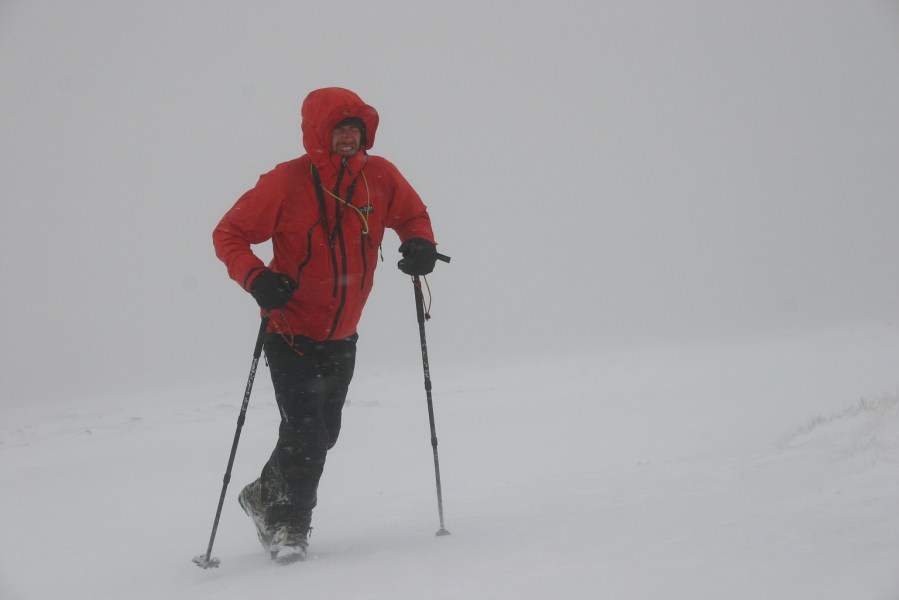Following the tragic death of Steve Perry and climbing partner Andy Nisbet last week on Ben Hope, we look back at one of Steve’s most incredible outdoor accomplishments. In this feature, first published in the June 2006 edition of The Great Outdoors, Steve recounted the epic story of his continuous winter round of the Munros, Scotland’s mountains over 3000ft
I leaned into the walking poles and pushed forward, hard then harder. Nothing!
I tried again, leaning more and more into the wind. Head down, all I could see were my new boots, fresh out of the box this morning. I wondered what they’d look like after 100 Munros. Will I make it up 100 Munros? Will I make it up the first?
I pushed again and moved this time. Unable to look into the wind I could only hope the summit was nearing. I chanced a glance and got a face full of driven hail – but there it was, 20m ahead. Thank God! I fell into the circular shelter exhausted by the wind. Ben More’s wild summit was no place to hang around – there’d be no sandwiches up here today.
The descent gave plenty of food for thought anyway. Had I committed myself to a challenge beyond my abilities? Could I really backpack over all 284 Munros, through a Highland winter? On top of that, could I manage it on foot in the 121 days that Martin Moran had suggested, 20 years ago, in his book The Munros in Winter? If Ben More was this bad, how would I cope when the heavy snow arrived? After all, I’m no experienced winter mountaineer like Martin Moran. I’m a hillwalker with so few winter outings under my belt I can count them on two hands and still have a finger left to point and say, “You’ve no chance Perry!”
“Had I committed myself to a challenge beyond my abilities? Could I really backpack over all 284 Munros, through a Highland winter?”
Luckily, for the sake of my confidence, December had – on the whole – some great weather, enabling me to gain time on the schedule I’d set myself, and settle into the challenge.
By Christmas Day I felt the weather was giving me an easy ride. Apart from an Arrochar Alps snowstorm and the occasional drenching, there had been nothing to rival the first day’s weather on Ben More. I wouldn’t go so far as to say I was hoping it would snow but, come on, this was easy! The day was spent hiking into Glen Etive ready to climb the five Munros there on Boxing Day. It was beautiful and sunny but I would much rather have spent the day at home with my family.
By the afternoon of December 30 there had been a veritable weather reversal – I now wished it would stop snowing. A blizzard had kept the Glen Coe teashops full and the rescue teams busy. It was my first day off after 29 straight days on the hill and I felt guilty: “The first real snow comes along Perry and you bottle it!” The only recompense was pub-talk of 70mph winds on the summits; I could live with sitting that out.
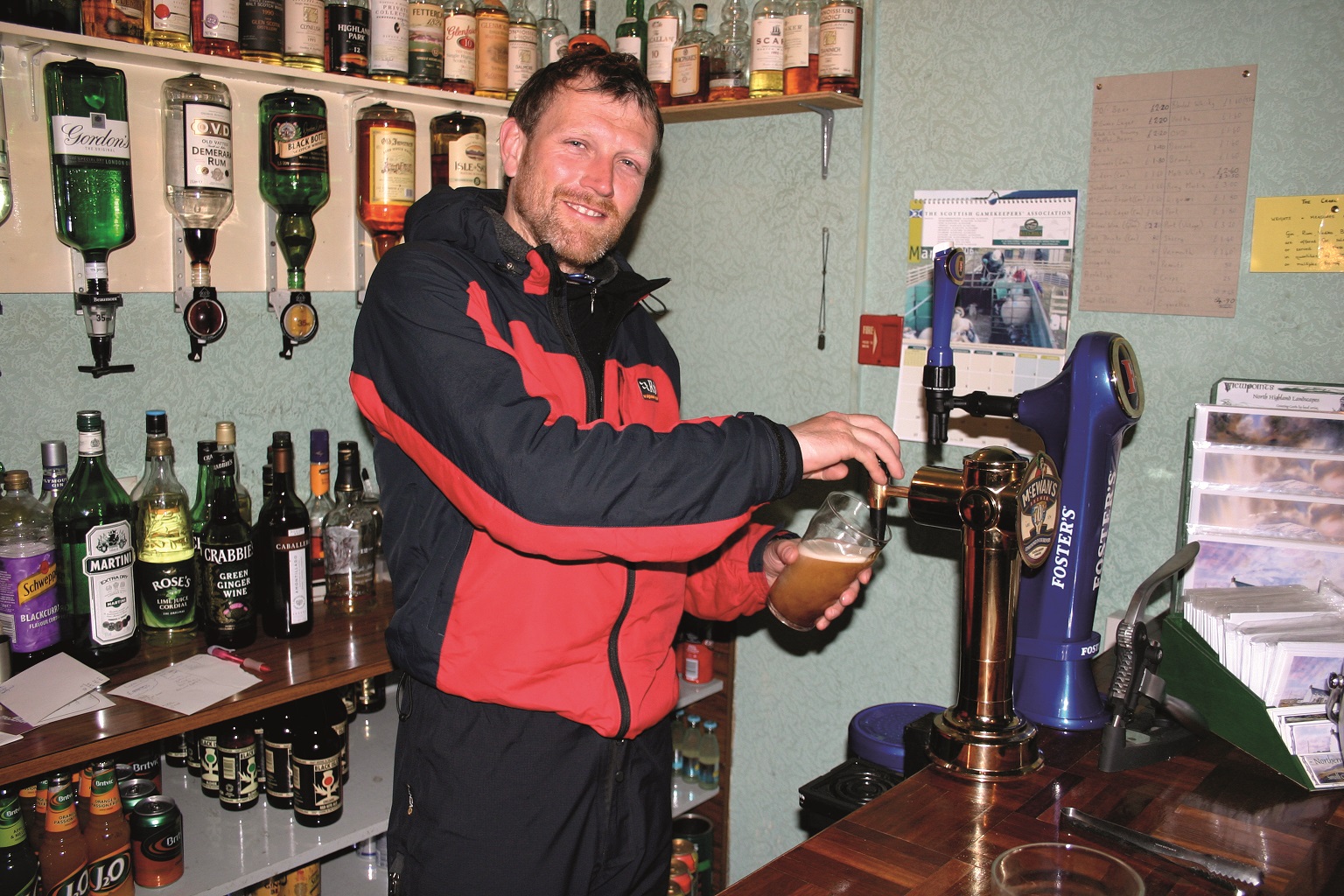
Calmer weather on New Year’s Eve made for the most enjoyable day yet, traversing Bidean nam Bian. It wasn’t quite blue skies but the ridge looked truly alpine with its new mantle of white powder. I even managed a few pints to celebrate Hogmanay that evening.
New Year was seen in with a traverse of mainland Scotland’s toughest ridge, the Aonach Eagach. My fears for the crossing were unfounded. Five hours after ascending from Glen Coe, I dropped into Kinlochleven with a spring in my step having spent a magnificent day tackling the icy climbs and loving every minute of it.
High pressure again moved into the Highlands, bringing cool air and blue skies which allowed me to change plans and gain time. The Mamores – 10 mountains that tower between Kinlochleven and Glen Nevis – were crossed in a fabulous 15-hour day instead of the three scheduled days.
The next morning saw me climb Ben Nevis with snow underfoot and a hot sun on my back, a wonderful day for the highest point of the trip. Camped high on the side of Aonach Beag, I watched a sunset that, despite the cold, made me damn happy to be there.
The following morning 50mph winds shook me awake and made it a struggle to decamp, fighting to keep warm. The winds continued throughout the day on the Grey Corries, after which I was sent battered and drained into the depths of the glen, having been given a stern lesson in how harsh and varying the Scottish weather can be.
“I was sent battered and drained into the depths of the glen, having been given a stern lesson in how harsh and varying the Scottish weather can be”
Easier days followed, enabling me to re-group and prepare for the remote Ben Alder Forest. I headed in with a pack crammed with food and fuel, excited at the prospect of self-sufficiency and the unknown. A lung-bursting effort with the heavy pack saw me across two more Munros to make base at Culra Bothy. The next morning the bothy thermometer registered – 8°C and an icy wind scathed outside. The day went well until a bad slip on ice landed me on a sharp rock and gave me a chest injury I thought would end the walk.
I fought on through blizzard conditions, in severe pain, and eventually staggered down the slopes of Carn Dearg back to the bothy. I hardly slept that night, despite being completely shattered. The pain jolted me awake every time I rolled on to my injured side.
Next morning, just when I thought things couldn’t get any worse, they did. The temperature had risen by around 12°C and the rain was coming down in buckets. A hard, painful day on the South Laggan hills turned into the worst of the trip. Returning to Culra that evening I approached the Allt Cam which, in my Yeti gaiters, had been an easy crossing that morning. I stopped dead in my tracks: the volume of water melting in the mountains had burst its banks. No rocks protruded above the surface, it was just one black sweeping mass, anything between waist- and chest-deep. My heart sank. I knew by the sheer size of it there would be no point in heading upstream, I would have to go for miles to find a crossing. I approached the edge with a heart almost bouncing out of my chest. I’d never crossed a river this deep, certainly not one moving this fast. I had to keep calm – panicking would see me swept into Loch Pattack. I lowered myself in and could not believe the pull of the current. Then I was right in: the icy waters breached my waterproofs, the cold took my breath away and at that point I nearly baled out and climbed back on to the bank.
“No point now fella, you’re soaked already.” I kept my back to the river and the Pacerpoles out front and began side stepping, crab-style. Bloody hell! It seemed a long way to the far bank. A few more steps and the water was bursting up my back and trying to force me over the top of the poles. Finally things got too much and I just lunged for the far bank. Swimming with the current I grabbed at the bank and somehow managed to gain purchase. I was so heavy pulling up on to the bank, everything from the chest down being totally soaked.
The day held one more surprise before it was finished with me. I found myself walking into a head wind that made the last three kilometres to Culra feel like 30, and chilled my sodden body to the bone. I don’t know how I would have coped that evening without the bothy fire.
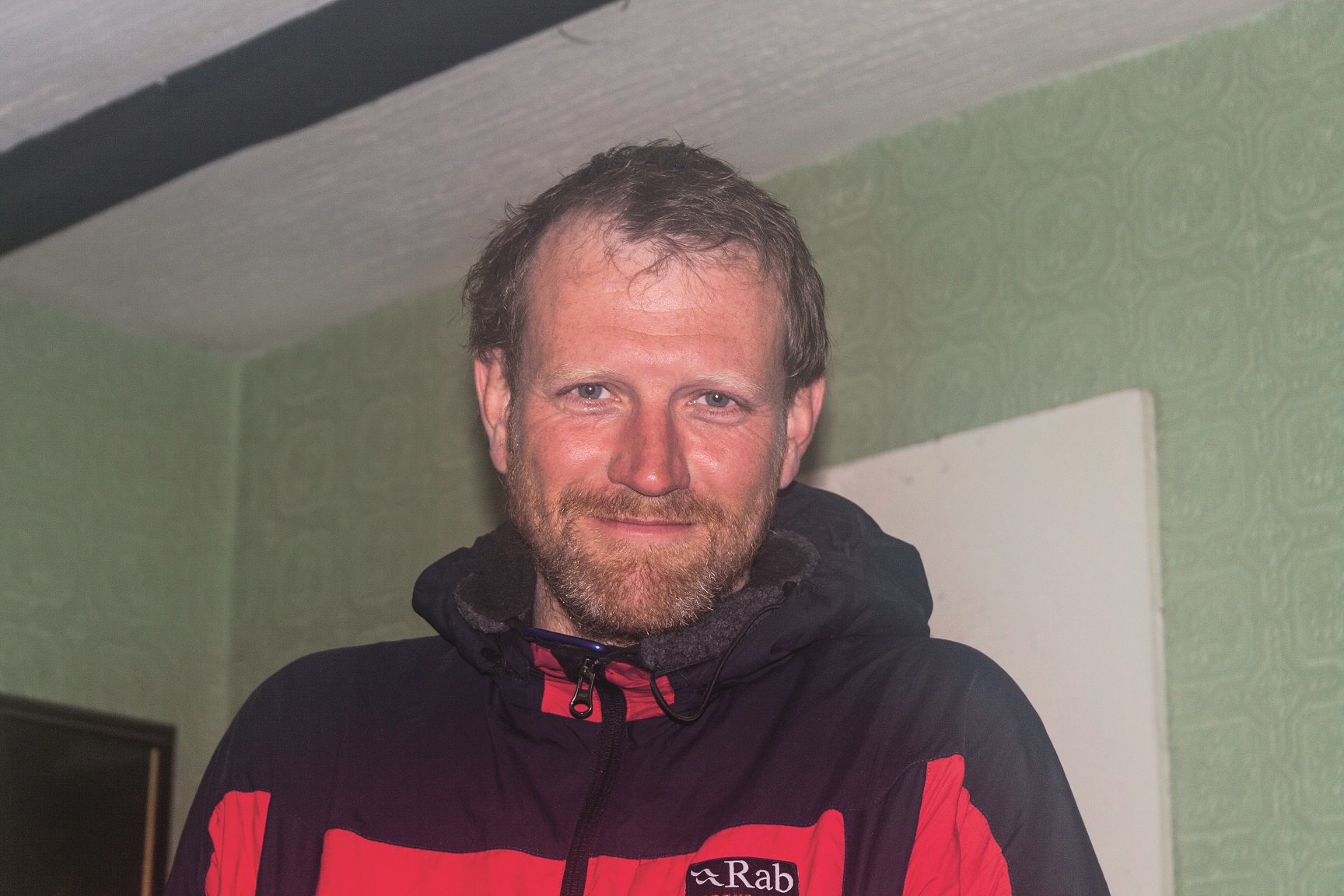
With immense relief I made it to Dalwhinnie the next day, the pack’s hip belt actually helping to support my chest and easing the pain slightly through the long walk out.
A nurse there confirmed one rib broken and one cracked. I was also given a harsh telling off for not heading out straight after the fall and was told to rest for a week at least. No chance! The schedule would not allow it, though a gale the next day at Drumochter forced a day’s rest which I never complained about.
The rain continued on my journey east into the Southern Cairngorms. At last! A cold spell brought snow – much favoured over the rain – and a welcome rendezvous with a good friend from home, Rick Wilson. We both battled through a blizzard to meet at the Tarf Bothy, Rick arriving from the south, myself from the east.
Over the next few days we climbed the Glen Tilt hills before Rick headed home and I pushed on to the Glen Shee ski centre, rain, sleet and a blizzard sending me scurrying to the road there.
Good news at last. High pressure, set for the foreseeable future, couldn’t have come at a better time. Could I round up my eastern push and the giants of the Northern Cairngorms before it ended? Four days later I was back in Braemar, Mount Keen, my most easterly Munro, climbed.
The Northern Cairngorms are famous in mountaineering for many things but the blizzards there are legendary. Winds of 170mph have been recorded in winter, so careful planning had to be adhered to and escape routes always kept at hand.
“The Northern Cairngorms are famous in mountaineering for many things but the blizzards there are legendary”
There was no need. The best winter weather I’ve ever experienced in Scotland was encountered over the run into Kingussie and the last leg of my second month, the highlight being a western plateau cloud inversion, snowy peaks standing out like islands on a sea of cloud, as far as the eye could see.
Heading west from Kingussie at the outset of February, my Cairngorms luck continued as I experienced three more days of inversions on my run towards Spean Bridge, where I picked up fresh supplies, kindly deposited in advance by good friend Lorraine McCall, and made my way to Loch Arkaig.
I was now officially in the west – “west is best” goes the saying, we’ll see! Here my luck with the weather ran out and I spent 36 hours pinned in a bothy by a deluge that caused surrounding rivers to burst their banks and cleared the mountains of snow. I could ill-afford to lose more time so out I went, arriving at Kinbreak Bothy in Glen Kingie soaked but two more mountains better off. I slept uneasily, knowing my next summits were defended by a swollen river and that the rain was still beating down outside.
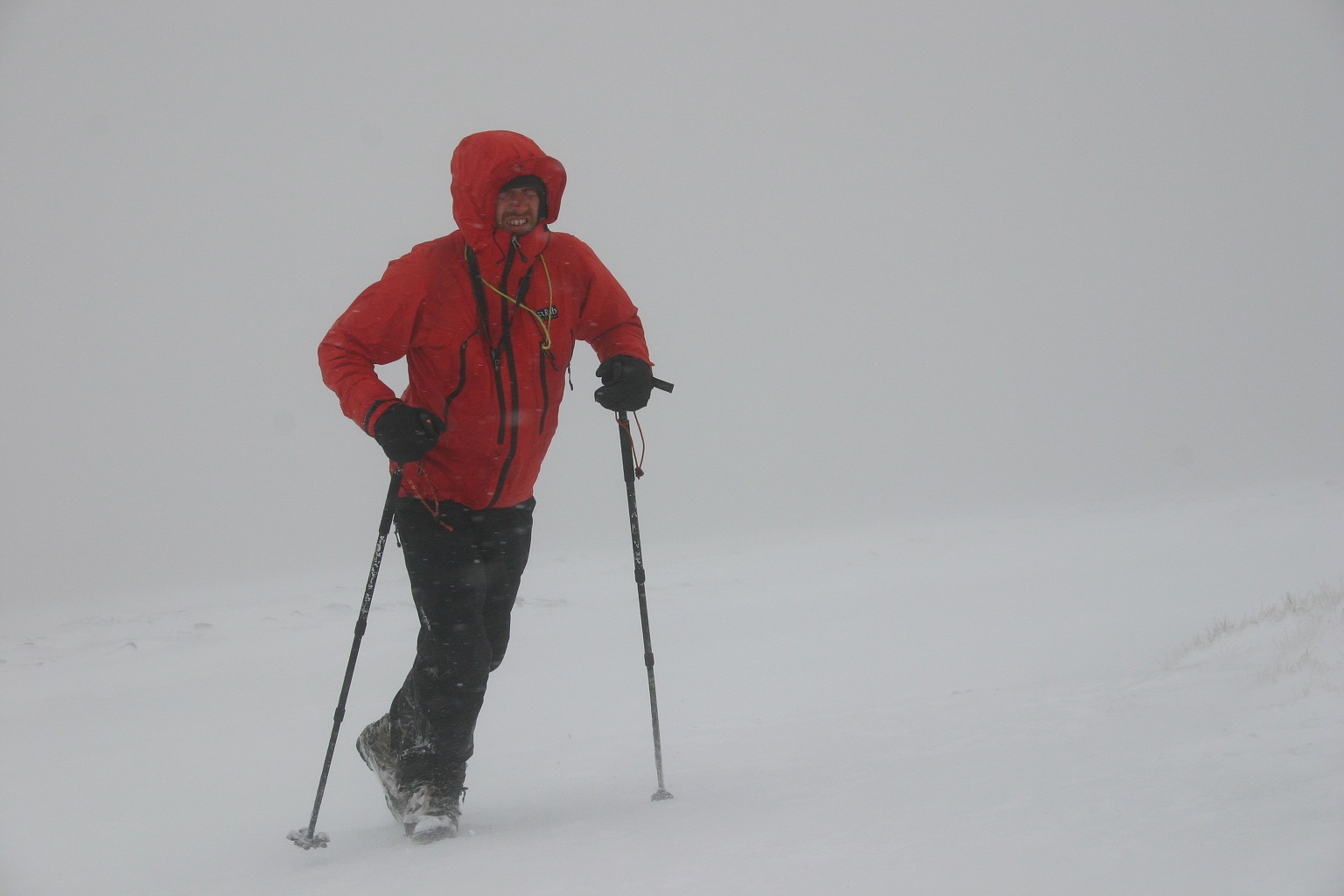
Stepping out of the bothy the next morning, I found the night had borne a miracle. The air was crisp and the night’s rain had turned to snow which covered the surrounding mountains. The river had emptied its waters east and was now just a hop, skip and a jump to the far side.
My journey entered Knoydart, a place famous for fantastic mountains and remoteness. I broke trail through virgin snow to Knoydart’s summits, not once seeing footprints, loving the feeling of loneliness. Finally, at Glen Shiel, I reached the first main road I’d encountered in eight days and had a well-earned bath at the Cluanie Inn.
Three more days of relatively good weather and I had climbed every mainland Munro south of Glen Shiel. I was ready for Scotland’s toughest test: the Cuillin Ridge on the Isle of Skye.
Negotiations in the West Coast village of Glenelg secured a boat to the Misty Isle. A 25-mile road slog the next day saw me poised beneath the north end of the Cuillin, where I was joined by Lorraine McCall and Neil McAdie, Rab’s marketing manager, here to help me out with the ridge’s technicalities. On the snow-covered Cuillin, hillwalking ventures deeply into the realms of winter mountaineering.
“On the snow-covered Cuillin, hillwalking ventures deeply into the realms of winter mountaineering”
Adorned with harnesses, crampons and ice axes we made our way to the first summit. Conditions were not good. The hoped-for hard ice and snow was in fact soft, unconsolidated powder, no good for axes or crampons but still treacherously slippy. It became a slow, stressful experience – for me anyway – taking six long days. Each morning we left at 6am, not returning until well after 7pm having at best scaled two peaks. Crossing the narrow aretes between the summits was an experience I would not like to repeat. Any slip would certainly have been to an untimely death, hundreds of feet below. Every night I dreaded the fact that the following morning I would have to go through it all again.
The crescendo of fear was reached when scaling the snow and ice coated Inaccessible Pinnacle, an 80ft plinth of rock only a few feet wide. Without the help of my friends and local guide Mike Lates, I’m sure the challenge would have ended here. Instead, I was steered through and made it back to the mainland in one piece.
The end of February saw me lose two more days to heavy, sustained snows in the Western Highlands. I was now behind schedule for the first time.
If sitting helpless and watching the snow come down wasn’t torture enough, being out and breaking trail was. Every metre of ascent had to be fought for through thigh-deep snow and A’ Chralaig – my first summit in the new snow – was over 1100m in height. It was exhausting work and any hopes of gaining the day’s intended five summits were in tatters by the top of the first. It was already past noon.
From the summit myself and Peter, a friend, crossed a knife-edge ridge running north for two miles, towards the next summit, Mullach Fraoch-choire. The wind had blown the snow into enormous overhanging cornices, resembling whale’s tails in size as well as shape. They were utterly treacherous to cross. We never knew for certain whether the snow we were on was supported by rock or fresh air.
The going got progressively more technical the nearer we got to the second summit. Pete decided he’d had enough and turned back. It was daunting, being alone in the mist and the snow, the only consolation being that somebody knew where I was. From the summit I reversed the route trail into Glen Shiel, thankful that the trail had been broken. Two summits out of five planned and a very difficult day doing them… this snow was going to be tough!
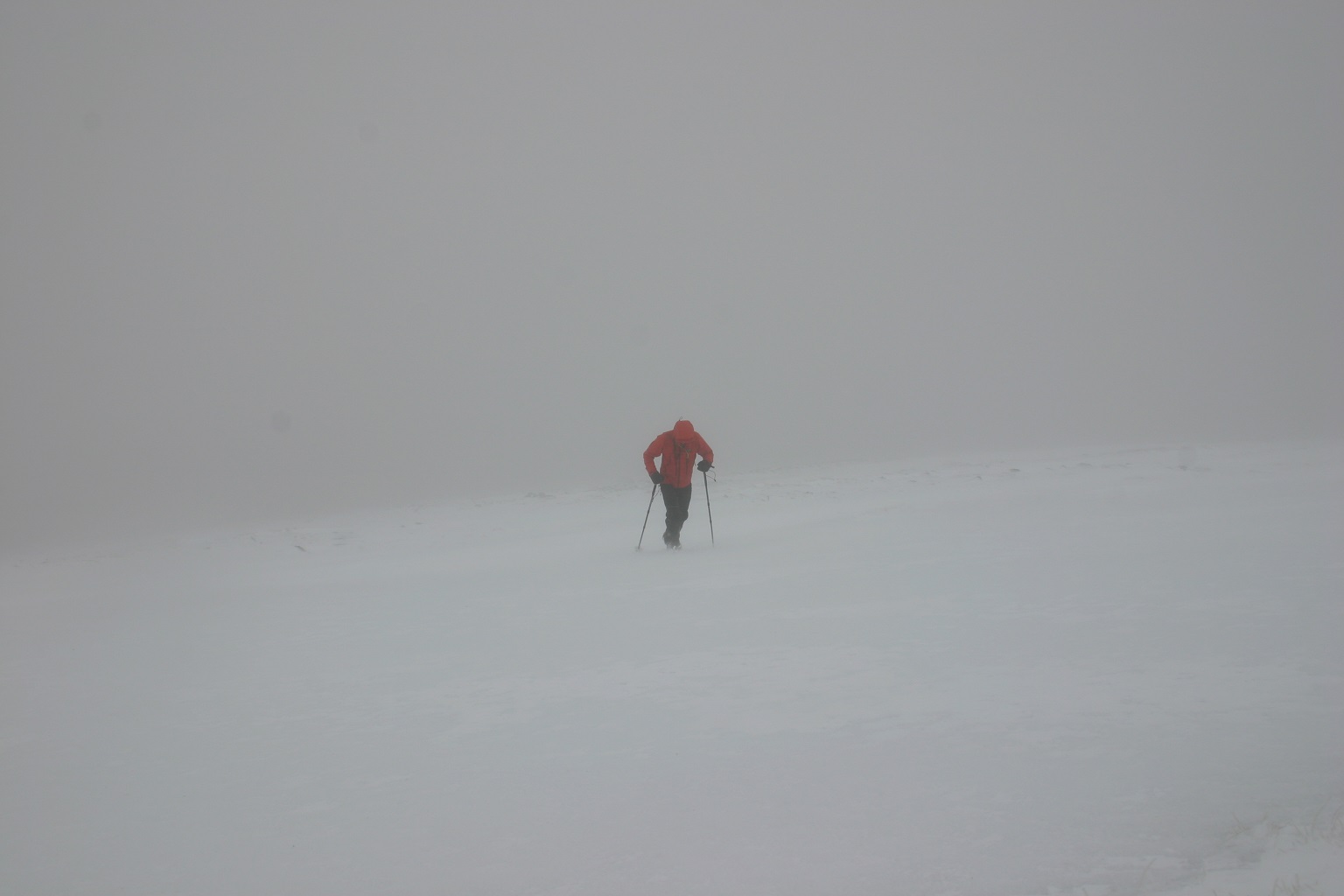
Over the next few days I had fantastic weather but the going was no easier on the ground, the deep snow never hardening enough to walk on top of.
Rick Wilson ventured up from Todmorden once more, accompanied by girlfriend Kirsty and sister Liz. Together we broke trail from Glen Shiel into Glen Affric. There we sheltered at Camban Bothy where I intended to base myself for the next few days. Unfortunately the roof was holed and bothy was full of snow. We were glad we’d made the effort of carrying in wood and coal or I’m quite sure we would have had a miserable night, it being around –10°C outside.
The next morning it was snowing again and looked to have been doing all night. There was no trace of our previous evening’s footprints on the track. Rick, Kirsty and Liz decided to head out and I couldn’t blame them – to be honest I envied them. I still had 25 mountains to climb before I reached civilisation at Achnashellach, 50 miles north.
The next two days became mentally the most trying of the trip and I reached a make or break decision the morning I left Camban. Should I continue north to Achnashellach or break out back to Glen Shiel, hope for a thaw and finish the challenge after my March 31 deadline? North was the cry – though the snow was coming down like 50-pence pieces at the time. For the next six days I was alone, the weather terrible, with long days of driving snow that turned to wet sleet every time I dropped below 1500ft. My morale hit an all-time low and for the first time I wanted to get it over with and get home.
That attitude helped in some ways. Every morning I was packed and away for 7am and would walk as late as 11pm, to reach the end quicker. When the day came when I would make the road, I romped over the two mountains that barred the way. I was smiling from ear-to-ear when I said hello to the gamekeeper whose driveway lead to the highway – he was the first person I’d seen for six days.
“I was smiling from ear-to-ear when I said hello to the gamekeeper – he was the first person I’d seen for six days”
The going became easier for a few days. The snow turned to rain and I had hostels to base myself in. The luxury didn’t last though and I soon packed the kit away ready for the Fisherfield Forest. Everything was going to plan and I was looking forward to a nice cruise into the finish when suddenly the weather bit back.
With fewer than 10 days to go a blizzard dumped 18 inches of snow over two days. The first I managed to get out and do what I needed to, but on the
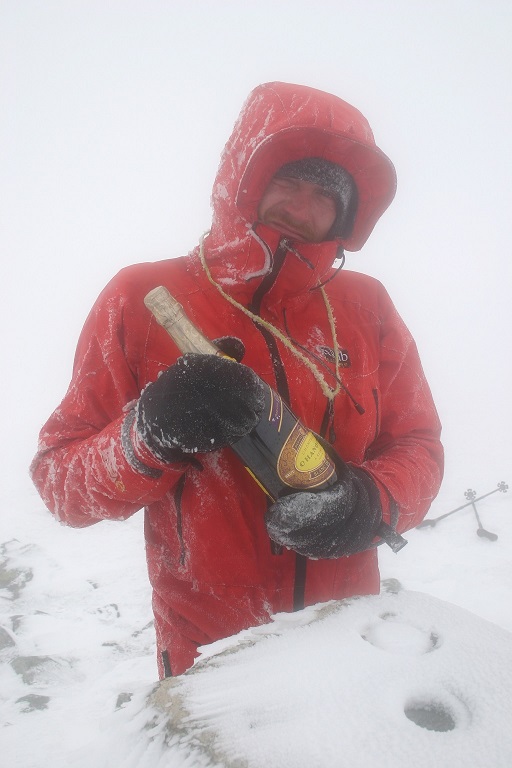
Celebrating the end of an incredible mountain adventure
second there was no chance. The following day I felt I was back in Glen Shiel, wading through thigh-deep snow, with the added difficulty of zero visibility. The only thing that got me through was fitness gained over the previous months, which certainly helped me keep to the schedule.
The last few hills posed no real difficulties, the new snow melting in the glens faster than expected. Before I knew it I was at the end of the road, with just one mountain to go and a mind full of mixed emotions.
Friends had travelled north for the last summit, Ben Hope: March 31, just as planned. The weather was atrocious. A blizzard on the last 1000ft sent Grampian TV’s cameraman scurrying back into the glen and postponed the summit party’s champagne celebrations until later.
“Until the bitter end,” as they say.
Thanks to Chris Townsend and John Manning for their photographs from the end of Steve Perry’s Munro round

